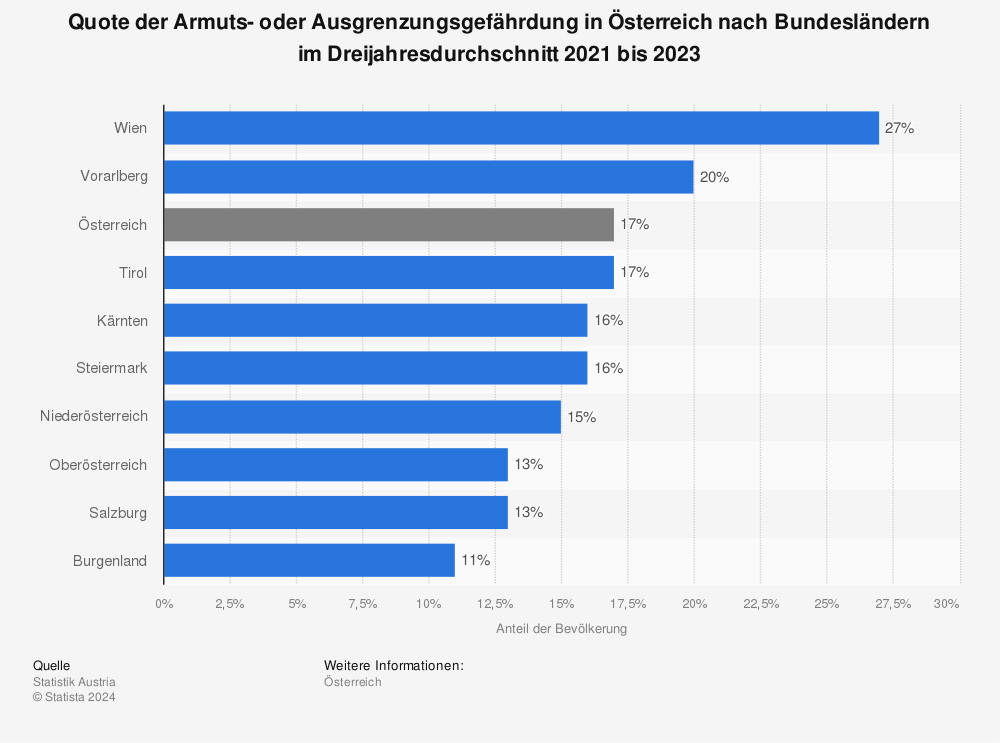Austria is generally seen as a rich country, and its cities often rank top in quality of life. According to data from Organisation for Economic Co-operation and Development (OECD), Austria’s gross domestic product (GDP) is on par with the OECD’s best performing countries, and inequality is lower than in most advanced countries.
Several other indicators also show how rich the country is – including the fact that about 72 percent of people aged 15 to 64 in Austria have a paid job, above the OECD employment average of 66 percent.
READ ALSO: EXPLAINED: Why is Austria so rich?
However obviously not every household enjoys the same standard of living in Austria. Austrian authorities are very clear when they say, “yes, poverty also exists in Austria”.
According to the country’s data agency Statistik Austria, about 17.3 percent of the people in private households (around 1.5 million people) are at risk of poverty or exclusion.
This means people who are in “significant material and social disadvantage” have a low household income relative to the median of the population or have no or very low “labour intensity” – meaning that they are unemployed or marginally employed.
What is considered poverty?
Poverty always means a lack of opportunities, according to the Austrian Die Armutskonferenz, a network association that fights poverty and social exclusion in Austria.
A “significant material deprivation”, the term for manifested poverty, happens when low incomes are associated with restrictions in central areas of life. For example, not being able to replace worn clothes, eat healthily, not being able to keep a home properly warm or cover unexpected expenses.
READ ALSO: EXPLAINED: How Austria’s new finance measures could benefit you
“Poverty is not only affected by those who sleep on the street or in cardboard boxes. In rich countries such as Austria, poverty is often only visible at second glance.”, Armutskonferenz says.
Those who live in poverty in Austria often experience exclusion, loneliness, and isolation – they can no longer afford to invite friends and family to dinner or occasionally go to the cinema, for example.

Who are the people at risk of poverty?
Children, women in old age, single parents, the long-term unemployed, and people without Austrian citizenship are particularly at risk, according to Statistik Austria.
A quarter of those affected by poverty in Austria are younger than 26 years old and dependent on their parents, who are most likely immigrants, unemployed, single parents or have jobs that cannot support a family.
READ ALSO: Cost of living: Where are rents rising fastest in Austria?
Women are particularly affected because they often are the primary (if not sole) carers in a family, staying at home or taking minor jobs instead of searching for full-time employment.
Moreover, since Austria’s welfare state is strongly linked to the labour market, women are often marginalised.
Where in Austria are those at risk of poverty?
A federal study shows that Vienna has the highest percentage of people at risk of poverty or social exclusion, 27 percent. While in Austria, the rate of people at risk is approximately 17 percent, in Vorarlberg, that number reaches 24 percent.
In Carinthia, 17 percent of the population is considered at risk, followed by Tyrol (16) and Styria (15). Salzburg and Burgenland have 13 percent of the people just within the threshold, and Lower Austria and Upper Austria have the lowest rates, at 12 percent and 11 percent, respectively.

Mehr Statistiken finden Sie bei Statista
What does Austria do to prevent poverty?
Austria has a strong welfare state which reduces the risk of poverty and protects most of the population from it – especially during crises such as the Covid pandemic.
Social benefits reduce the risk of poverty from 45 percent to 14.7 percent in adverse situations, according to Armutskonferenz. Unemployment benefits, emergency and minimum security, and housing and long-term care allowance have the most significant impact.
READ ALSO: EXPLAINED: How to claim your €150 energy discount in Austria
However, associations call on the government to implement further measures to combat and prevent poverty. For example, they ask for awareness-raising regarding approaches to minorities and marginalised people, improvement of allowances and family schemes, and more offers of free activities.
Social and care groups also ask for measures to reduce educational inequality, saying it is necessary to ensure education completion for all children – which will help prevent child poverty.
For young people, they claim it is necessary to fight unemployment and offer diversified education and training options.
How can I help reduce poverty in Austria?
There are several known and renowned associations that fight poverty in Austria. Armutskonferenz is one, but Caritas is also a very well-known organisation.
You can also get involved politically and voice demands for better policies and government assistance. It is also essential, the organisations say, to help ensure that prejudices and stereotypes concerning poverty experiences are not spread so that people in this situation can still have opportunities in life.



 Please whitelist us to continue reading.
Please whitelist us to continue reading.
Member comments